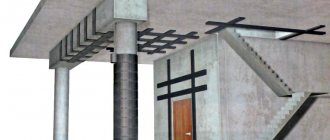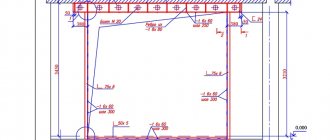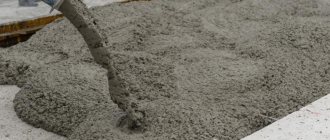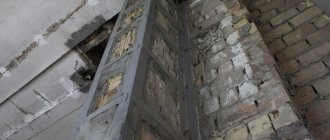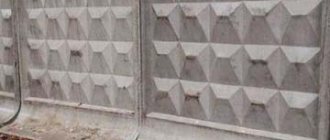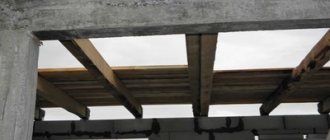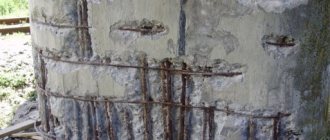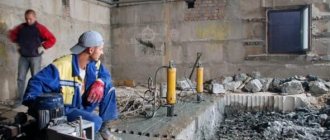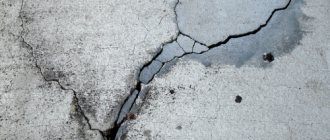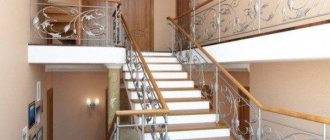There are situations when building structures require reinforcement. What to do? Construct additional reinforcing structures. However, there is material that allows you to dress them in a reliable supporting “corset”, the creation of which does not even require large-scale construction activities
We are talking about a material such as carbon fiber (CF), produced in the form of woven and non-woven fabric, continuous threads, bundles, lamellas, meshes, fiber and even dispersed powder. All these products are based on the finest chemical or organic fibers, in which, after step-by-step heat treatment (oxidation, carbonization, graphitization), almost only carbon atoms (up to 99%) remain. Viscose, polyacrylonitrile, lignin, phenolic and petroleum resins, etc. can be used as feedstock. The properties of CF - low specific gravity, chemical inertness, high resistance to temperature influences, as well as almost zero linear expansion - make it possible to produce composites from it that have become indispensable in aircraft and rocket engineering, in the production of electrical and radio equipment, automobile parts, melting and heat-conducting equipment, power plants and much more. The filtering and sorption ability of carbon fiber has found a place for it in the field of medicine and pharmacology.
The construction industry has not stood aside, where tapes, lamellas and meshes made of carbon fabric are used in external reinforcement systems to strengthen elements of buildings and structures (overpasses, bridges, tunnels, etc.). With their help, structures that are collapsing from wear and aggressive influences, due to uneven settlement or soil movements, can not only restore strength, but also increase their load-bearing capacity, without interfering with the structure.
This allows the use of carbon fiber to strengthen objects operated in earthquake-prone regions; when increasing the number of floors of buildings, as well as during redevelopments affecting the strength elements of the building.
Elements of buildings and structures made of reinforced concrete, brick and stone, wood, and metal are subject to carbon fiber reinforcement (in this case, a fiberglass layer is used to prevent corrosion)
Where is it used?
The main area of application is strengthening reinforced concrete structures.
The fiber is laid on those areas of the structure that bear the greatest stress. What are the reasons for strengthening building structures:
- physical aging of the object, actual wear and tear of the material and individual structural elements (floor slabs, columns, etc.);
- such damage to the concrete structure as to reduce its load-bearing capacity;
- redevelopment of the premises, in which adjustments are made to the load-bearing structural units;
- situations when a request is received to increase the number of storeys of buildings;
- strengthening of structures dictated by an emergency situation and its urgent resolution;
- ground movements.
But carbon fiber interacts so well not only with reinforced concrete. The same applies to metal structures that have a strength and elasticity modulus similar to carbon fiber. You can also work with stone structures, such as pillars and walls of brick houses.
Wooden floor beams also need to be strengthened if the condition of the beam system requires intervention, if the load-bearing capacity is obviously reduced.
Surface preparation before carbon fiber reinforcement
When reinforcing reinforced concrete structures with carbon fiber, the work begins with marking the structure - the zones in which the reinforcement elements will be located are drawn. These areas are then cleared of finishing materials, dirt and cement laitance until the coarse concrete aggregate is exposed. For this purpose, either angle grinders with diamond cups or water-sandblasting units are used.
The quality of the prepared base (the surface on which carbon fiber is glued) directly affects the compatibility of the structure with the reinforcement element, therefore, the following parameters must be controlled
- surface evenness;
- strength and integrity of the material of the reinforced structure;
- surface temperature of the structure;
- absence of dirt and dust;
- humidity;
- and others (a complete list and permissible values of controlled parameters are given in the technological maps for construction work).
Methods of strengthening (strengthening) the main types of slabs
A wide variety of slab types are used in construction. They can be monolithic, ribbed, multi-hollow. Depending on the degree and type of destruction, the method of reinforcing the floors is selected. Before starting work, the necessary calculations are carried out and a technical project is created.
When carrying out calculations, the presence and location of compressed reinforcement located along the width of the reinforcement bars is taken into account. Reinforcement of floors should be carried out by experienced workers.
Hollow-core slabs
Such slabs are restored by filling technological voids. This method is much more effective than installing an additional monolith. First, clean the slab from the screed. Then a furrow is made in it, up to 100 mm wide, along the slab above the voids. At the next stage, the surfaces are blown with compressed air.
Next, a vertical reinforcing frame and a horizontal reinforcing mesh are made. Then special slats are installed, and the voids are filled with concrete.
2 methods for monolithic floors
The most common method of reinforcement is to create another monolithic slab, which is placed on top of the old one. However, many experts believe that this method is not always effective. In some cases, through calculations it is possible to prove that the old coating, on the contrary, is loaded even more.
It is more reliable to strengthen the ribs using corners, having previously treated them by removing fat from the surface. The size of such a corner is 100x100 or 120x120 mm. It is placed under the edge of the slab. A gap of up to 120 mm deep is prepared in the supporting parts.
This is done so that there is somewhere to put the bottom shelf of the corner. It should be directed towards the inside of the block. In the second method of strengthening monolithic blocks, fragments of the floor are replaced.
U shaped slabs
This type can be strengthened in two ways. The first method has already been described - with the creation of a new concrete mass. The second method is to use a channel. It helps to redistribute the loads, most of which will fall on the floor beams and load-bearing walls. The same effect is achieved by a “corset” of welded beams.
Ribbed slabs
To repair such floors, three methods have been developed:
- They use the same technology as when repairing monolithic slabs.
- Install supporting columns.
- Trussed fittings are used. It is laid diagonally on the slab, thereby forming 2 stiffening ribs, thus strengthening the slab.
Carbon fiber reinforced concrete slabs
This type of amplification is considered the most progressive. In this case, the carbon tape is glued directly to the reinforced concrete slab itself.
What to do if the columns are overloaded
Many experts who have had to deal with the restoration of slabs believe that such methods in most cases do not completely solve the problem. They can be used when strengthening compressed columns that coincide with the projection of the working reinforcing bars of the frame. In this case, the columns are wrapped with bundles in several layers.
The harnesses are made of carbon fiber. If there are no harnesses, use strips of the same fabric. When using a set of these measures, the load-bearing capacity of the entire structure increases.
The slabs of any building are constantly under tension. They are acted upon by mechanical, statistical and dynamic forces. Additionally, they are destroyed by unfavorable environmental conditions and exposure to various chemicals. Therefore, examining their condition and determining the strengthening method is a responsible job.
When is this required?
Reinforcing the floor with carbon fiber is a relatively simple method. It is recommended to use it if there are obvious signs of damage. In general, carbon fabric sheets, tapes and meshes are used:
- When carrying out major repairs in a building or during its reconstruction;
- If errors are revealed in the initial design strength calculations, and the actual loads turn out to be critically large for structural elements;
- If the load-bearing capacity of the structure has decreased, cracks, holes or deformations appearing through the slabs, sharply reducing the strength characteristics;
- When the processes of destruction of floor slabs have begun, which are caused by prolonged exposure to shock loads, for example, from vibrations, the operation of stamping machines;
- If there are significant deflections of the floors that exceed standard values;
- When there are signs of natural aging of materials: concrete is crumbling or the reinforcement in reinforced concrete is covered with rust;
- In case of increased load on the load-bearing elements of the building, due, for example, to the appearance of new heavy equipment in the workshop;
- If a building is located in a seismically active zone or an area with unfavorable atmospheric phenomena, its ceilings are negatively affected by displacements of the earth's crust, they are corroded by chemically active substances contained in the air.
Advantages of composite materials
Reinforcing load-bearing structures with carbon fiber is a progressive and modern method that has a number of advantages due to the properties of the material itself:
- In order to carry out reinforcement work, you do not need to use special equipment with a large load capacity, since the material is light in weight.
- The technology of external reinforcement of reinforced concrete structures using composite materials allows this work to be completed up to 10 times faster than using other technologies.
- The material allows you to achieve a fourfold increase in the load-bearing capacity of the structure compared to the same indicator when using other materials.
- The weight load on the structure does not increase
- Carbon fiber is not susceptible to corrosive processes and negative environmental factors
- The service life of the material can be more than 75 years
- Today, carbon fiber is the least expensive and most effective way to correct errors in design and preliminary construction work.
The effectiveness of this technology can hardly be overestimated. Its use helps to avoid serious operational problems when structures are damaged as a result of natural wear and tear or mechanical stress. Strengthening will not only minimize the consequences of the damage received, returning the structure to its previous load-bearing capacity, but even significantly increase it. In addition, a dense and waterproof composite material will protect the concrete from moisture and prevent corrosion in the reinforcement.
Coal concrete
Carbon concrete was developed at the Technical University of Dresden, and if compared with reinforced concrete, familiar to any builder, there is not much difference - just the metal reinforcement frame has been replaced with carbon. Carbon fiber is used for building concrete and strengthening structures in the form of non-woven fabrics, meshes, roving and a wide variety of carbon fiber textiles. Since carbon threads are super strong, combinations of tens of thousands of similar threads give unique strength qualities to load-bearing structures.
Carbon concrete in monolithic construction
To prepare carbon concrete, carbon fabric is used - non-woven fabrics, the threads of which have a thickness measured in microns. But a fabric made from tens of thousands of these threads is the super-strong basis of materials called carbon fiber textiles. Mesh and micro-reinforcing fiber are also used. The main use of carbon concrete in new construction and reconstruction:
- Carbon concrete load-bearing elements and structures cannot be compared with reinforced concrete in terms of weight - they are several times lighter. A ceiling, wall, column made of carbon concrete with a strength similar to reinforced concrete can be much thinner and lighter. In turn, reducing the weight of the building, provided the foundation soils are stable, allows the use of a much less massive and expensive foundation, and given that the cost of the foundation is 25-40% of the total price of the house, the savings are not bad.
- During major repairs and restoration of old buildings, carbon concrete and coal materials are used to strengthen the load-bearing floor, support posts, and purlins of all types. Experts and researchers of the innovative material carbon concrete say that by strengthening concrete with carbon fiber reinforcement, it will be possible to reconstruct even structures that were subject to demolition before the advent of carbon concrete.
Application of overlays
The use of overlays for strengthening and repairing floor beams is used when there is damage in a certain area. The point of restoration work is to install wooden plates on both sides of the problem area, which are attached to entire parts of the beam with bolts complete with nuts and washers.
Moreover, the overlays can be installed both on the sides of the beam, and on the top and bottom. However, in any case, for repairs it is necessary to use dried wood treated with an antiseptic or antifungal solution.
If a section of a floor beam is damaged to such an extent that practically nothing remains of it, linings must be installed along the entire length of the beam: from one wall to another. Metal profiles should be used at junction points. In particular, a steel prosthesis, which is a metal strip or metal rod of the appropriate diameter bent at 90º.
Calculation of reinforcement of reinforced concrete structures
Calculation of strengthening of reinforced concrete structures (walls, floors, foundations, columns) and other building systems involves responsible and complex work that can only be performed by highly qualified professionals. It is definitely not recommended to carry out calculations on your own. Usually the task is entrusted to entire departments of design organizations - finding specialists within Moscow and distant regions is not difficult.
What data is needed to calculate the reinforcement of reinforced concrete structures:
- The results of examinations and inspections of those building structures that are planned to be strengthened - without them, calculations cannot be carried out.
- Detailed photos of the surface are highly desirable.
- Detailed explanations of what and how to do.
Typically, calculations of strengthening structures are carried out within 1-5 days, but it is advisable to clarify, since the period may depend on the volume of work, the workload of specialists and other equally important parameters.
Reinforcing concrete with carbon fiber is a modern and effective method of increasing the load-bearing capacity of structures, eliminating the consequences of accidents, reconstructing old elements and strengthening new ones.
Difficulties in strengthening monolithic floors
Strengthening reinforced concrete floor beams is a complex engineering and technical problem, in the process of solving which it is often necessary to use both standard (reinforcement, extension, use of mesh) and non-traditional restoration methods. At the same time, a personal project plan is developed for each specific building, taking into account the requirements not only for strength, but also for aesthetics.
There are two fundamentally different ways of strengthening a monolithic floor:
- transferring the entire load or part of it to the reinforcement being built;
- increasing the load-bearing capacity of an existing load-bearing structure.
In the process of strengthening reinforced concrete floor beams, we often encounter the following problems:
- impossibility of using all available mechanization means;
- obviously limited conditions (cramped environment, insufficient free space, etc.);
- the need to carry out complex preparatory and additional labor-intensive work.
Professional skills allow us to guarantee the quality of service delivery, regardless of the difficulties encountered.
Preparation of components.
Carbon materials are supplied coiled and packed in polyethylene
It is very important not to stain them with dust, of which there will be a lot of dust after grinding the concrete, otherwise the carbon fiber will be impossible to saturate with the binder, i.e. there will be a manufacturing defect
Therefore, the procurement area should be covered with dense polyethylene and the required length of carbon material should be unrolled along it. Cutting carbon tapes and meshes can be done with a stationery knife or metal scissors, and carbon lamellas can be cut with an angle grinder with a metal cutting wheel.
Adhesives are usually used in two components – i.e. it is required to mix two materials in a certain proportion. It is necessary to strictly follow the manufacturer's instructions and use scales or measuring cups when dosing. Mixing of the compositions occurs by gradually adding one component to another with constant stirring with a low-speed drill. Dosing errors, or incorrect mixing of one component with another, can lead to boiling of the adhesive.
In recent years, most manufacturers have been supplying adhesives in kits - i.e. in two buckets with already dosed volumes of components. In this way, you can simply mix the contents of one bucket into another (the bucket is specially supplied with a larger volume (half empty)) and get a ready-made adhesive composition.
Polymer cement adhesives (for carbon meshes) are supplied in bags and sealed with water according to the instructions, like any repair material.
It should be remembered that the adhesive has a limited lifespan - about 30-40 minutes, and it is sharply reduced when the temperature rises above 20 ° C, so the volume of the prepared adhesive should not exceed the physical capabilities of its production.
Installation of carbon fiber materials.
Depending on the type of carbon fiber material, its installation technology differs significantly:
Installation of carbon tapes can be carried out using the “wet” or “dry” method. In both cases, a layer of adhesive is applied to the base, but with the “wet” method, the carbon tape is first impregnated with adhesive and then rolled onto the base with a roller, and with the “dry” method, the tape is rolled onto the base, and then it is impregnated with a layer of adhesive on top. Impregnation of carbon tape is carried out by applying a layer of adhesive to its surface and pressing it with a paint roller or spatula, ensuring that the top layer of the binder penetrates deep into the carbon fiber, and the bottom layer of the binder comes out. Carbon tapes can be laid in several layers, but when sticking to a ceiling surface, it is not recommended to apply more than 2 layers in one shift - the material begins to “slip” under its own weight.
It should be remembered that after the adhesive has polymerized, its surface will be smooth and it will be impossible to apply a high-quality finish to it. Therefore, it is necessary to apply a layer of coarse sand over the “fresh” reinforcement element.
When installing carbon lamellas, the adhesive is applied to both the structure and the reinforcing element. After this, the lamella is rolled to the base with a paint roller or spatula.
Installation of the carbon mesh is carried out on a moistened concrete surface. First, the first layer of polymer-cement composition is applied. It can be applied either manually or mechanized using shotcrete. A carbon mesh is rolled out over the “fresh” layer of polymer cement with slight indentation into the composition. The most convenient way to do this is with a spatula. Then it is necessary to maintain a technological pause until the composition begins to set. The setting time depends on the chosen composition and ambient temperature, but the required condition is that the polymer cement is difficult to press with a finger. After this, a covering layer of polymer cement is applied.
Features of increasing strength by various methods
The increase in load-bearing capacity will depend on the choice of technique. The choice depends on the material and features of the building itself. But carbon fiber is considered the most universal and most effective means for slabs. Depending on the type of slab, the following actions are performed:
- Reinforcement of hollow-core floor slabs with material is carried out by gluing canvas to the surface from below. It is glued with a certain step. In this case, several layers of canvas can be applied, which determines the degree of increase in strength.
- Monolithic slabs used for flooring are reinforced in a similar way, but the carbon tape is glued longitudinally over the entire surface. This allows for increased seismic resistance.
- To strengthen ribbed floor slabs, carbon composite is glued to the bottom of the ribs. The number of layers determines the gain level. The supporting part of such a system is also strengthened with clamps made of unidirectional tape.
Basic methods of strengthening concrete objects
Reinforcement with carbon sheets is based on two methods:
Innovative - a method that has been mentioned more than once in the text (divided into “dry” and “wet” methods). It involves using a composite material (carbon, carbon fiber or Kevlar) using adhesives to create a strong bond. By fixing, usually with cementitious materials.
Combined – from the name itself it is clear that it combines several methods. Of these, innovative and traditional. The second method is to increase the strength level by using materials other than carbon fiber. Such materials are less convenient in construction, since they weigh relatively more. Thus, the combined method is to use carbon sheet and other reinforcing materials. This method is usually used in high-load areas.
What you should pay attention to when creating a strengthening project:
First of all, you should pay attention to the results of the analysis and examination of the structure. Such an analysis is carried out in the case of visible defects, when the level of strength decreases. What is the lifespan of a building? Old structures are more susceptible to destruction. It is necessary to collect information about the soil on which the construction of the facility is planned
It is important to indicate whether there are bodies of water that could create flooding, other existing natural features (aggressive influence of external factors) Information about emergency situations, regulations. It is necessary to indicate any existing defects. Actual characteristics of all materials used (concrete, steel, etc.)
d.). Information about previously enhanced parts. Data on possible increasing loads.
Basic techniques of external reinforcement
| Technology | How it is done | Wear level | Implementation method |
| Changes in schemes | Reducing the span when installing additional support | No more than 60% | Arrangement of steel spacers. |
| Increasing the section of an element | Creating a structure that will partially take the load | No more than 40% | For wooden floors, an overlay, a wooden or metal “prosthesis” is installed. Installation of new structures that rely on existing or newly created elements. Arrangement of metal clamps and reinforced concrete clips - for reinforced concrete slabs. Welding of an additional profile, concreting a steel beam - for steel elements. |
| Creating a New Feature | Redistribution of load when transforming a definable into an indefinable system | ||
| Construction of a new structural element that will carry the load instead of the existing slab | No more than 60% | ||
| Unloading objects | Involves replacing heavy lubricant or backfill with modern materials to reduce the weight of the slab | No more than 60% | |
| Identification of unaccounted safety margins | The structure is recalculated according to new standards, which will take into account the actual nature of the work of the concrete floor. | No more than 40% |
Carbon fiber reinforcement
Carbon fiber reinforcement is a method of strengthening wooden floor beams, which is not entirely traditional, but is used in cases where the room has a small area or for other reasons when it is not possible to apply the above methods.
Carbon fiber is an innovative material that perfectly copes with any mechanical loads, including bending loads.
Carbon fiber elements are produced in various modifications, including plates, sheets, threads, tapes, or simply in the form of fabrics. The process of reinforcing beams with carbon fiber involves layering layers of glue (epoxy resin) on top of each other until the beam is sufficiently rigid.
After the glue hardens, the layers form a monolithic coating, with characteristics not inferior to metal.
Carbon fiber is a material of the future, from the past
The material was discovered by Thomas Edison in 1880 as part of his research on incandescent lamp filaments. In the last 10 years, at the instigation of foreign colleagues in the form of supplies of expensive carbon fiber products, domestic developers and manufacturers have begun resuscitating hydrocarbon projects begun during the Soviet period in all areas.
Everyone knows that carbon is needed in every form, in every industry. This is the production of literally everything that is not made of metal, glass, wood or concrete. But its main advantage is that it can not only complement traditional materials, but also replace them with benefits for humans and nature.
Video report on Russian carbon fiber production
We use modern technologies
Recently, there have been experimental attempts to replace metal reinforcement when reinforcing the floor with carbon fiber or carbon fiber reinforced plastics. Indeed, materials, mainly cords and fabrics based on carbon fiber or Kevlar, used in the manufacture of body armor, have even higher tensile strength than traditional metal reinforcement.
Where is it better to apply
The use of such materials must be subject to certain requirements:
- the surface of the building element must be perfectly leveled (down to fractions of a millimeter);
- the glue must be selected so that it creates the necessary adhesion (cohesion) between the surfaces to be glued and is chemically neutral to their structure;
- ensuring reliable protection of the structure during subsequent operation (materials such as carbon fiber are difficult to tear, but easy to cut).
Prices for design and strengthening of construction projects
| Type of work | Volume | Price |
| Reinforcement with rod reinforcement | from 50 m2 | From 95,000 per cubic meter |
| Strengthening the floor using metal structures | from 50 m2 | From 78,000 thousand rubles. per ton. |
| Strengthening beams with composites | from 30 m2 of fabric | From 7010 thousand rubles per sq.m. |
| Reinforcement of floors with carbon fiber | from 50 m2 | From 7010 thousand rubles per sq.m. |
| Creation of design documentation for strengthening the floor. | from 50 m2 | From 100,000 thousand rubles. |
| from 1,000 m2 | From 5,000,000 million rubles. | |
| from 5,000 m2 | From 10,000,000 million rubles. | |
| Strengthening the crossbar or beam. | from 50 linear m | From 78,000 thousand rubles. per ton. |
| Reinforcement of beams with metal structures. | from 3 tons of metal | From 78,000 thousand rubles. per ton. |
The company's employees have completed several projects in Moscow. The service is provided at a time convenient for the customer. The reinforced structure does not change the geometric shape and does not increase the load. You can submit an application through the website or by phone. The specialist will answer your question and agree on the details of cooperation.
Send the project for cost calculation
Installation of carbon fiber to reinforce concrete
Strengthening structures is a necessary stage for the construction of a durable and high-quality building. The main purpose of using amplifiers is to increase the strength of load-bearing characteristics. Such technologies are necessary for the construction and restoration of structures after exposure to external irritants.
In particular, in case of local damage, there is no point in dismantling the structure and erecting a new one. It is much easier to correct the situation if you know how to use carbon sheeting.
In the photo above you can visually restore the full picture of all of the above. Installing carbon fiber is simple enough to do it yourself. The main thing is to know the installation methods and basic principles before performing the installation:
- Before installation work, it is necessary to level the surface to be repaired, then remove the top layers of dust from it.
- Eliminate all visible dents, cracks, and other defects on the working surface. Covering them tightly with cement compounds.
- Perform leveling, smooth out all protruding irregularities.
- It is recommended to draw markings for neat and easy gluing.
There are two installation methods
- "Dry method". Materials with adhesive compounds are used as adhesives. First of all, binders for installation are mixed. The carbon fiber is cut to the required size. The adhesive is applied to the surface to be repaired. The cut fabric is glued to the adhesive composition, and a covering layer of polymer-cement composition is applied on top. If desired, sprinkle with sand for better grip.
- The “wet method” is somewhat different from the first one. After mixing the binding compositions for installation, the fiber is cut in accordance with the required sizes and shapes. The adhesive composition is applied to the surface to be repaired. In addition, it impregnates the canvas on both sides. After which the canvas is carefully glued and sprinkled with sand. The final stage is the application of a protective coating with a polymer-cement composition. Perform final finishing.
Carbon fiber reinforcement is used to improve the strength of buildings made from a variety of materials. Concrete, reinforced concrete buildings, structures made of wood, metal, and stone materials are suitable for strengthening.
The reinforcement method can be used to strengthen structures of any complexity and geometry (arches, columns, load-bearing walls, ceiling openings, etc.).
How to understand in which case the installation of reinforcing fabric is necessary? There are several main reasons why it is desirable to strengthen structures:
- Miscalculations and inaccuracies in the initial design of the building.
- The soil under the constructed facility turned out to be prone to mobility.
- The building was erected a long time ago; the first signs of wear and tear on materials and individual parts appeared. Early wear is possible in case of aggressive influence of external factors.
- Redevelopment, which entails changes to load-bearing walls and other fundamental structures.
- An increase in the level of safety is required to avoid unpleasant outcomes of possible accidents.
- The supporting structure of the room was significantly damaged. In this case, it is necessary to increase the strength level of this element.
- The construction of additional floors and their reconstruction require increasing the reliability of the lower part of the building.
- For preventive measures during the reconstruction of an old facility. Using carbon fiber reinforcement as an introduction to a new technological method.
- Any accidental damage
Why carbon?
Why are carbon materials used in construction to improve the sustainability of buildings? The fact is that they have special properties that distinguish them from all other substances and fibers:
- Unique technical characteristics: strength and rigidity, elasticity and superiority over steel.
- Fabrics, cords and other elements made from carbon fibers are not subject to corrosion. They are durable and resistant to various temperatures and aggressive chemical environments.
- A light weight. Carbon fiber weighs 10 times less than steel, 4 times less than aluminum. Therefore, carbon reinforcement is reliable and practical.
With all this, to use carbon materials there is no need to invent special design schemes or technological methods. In the case of ready-made carbon structural elements, the principles of working with steel and aluminum are taken as a basis.
Here are examples of several methods for strengthening structures with carbon fiber:
- increasing sections and strengthening beam crosses;
- arrangement of shirts and clips;
- installation of unloading racks and piles and additional fittings;
- strengthening of load-bearing units;
- adding special mixtures to structures, which include epoxy resin.
The technology of reinforcing walls with carbon fiber does not require large-scale reconstruction and allows repairs to be made without interrupting the functioning of the facility. Implementation of plans for carbon fiber reinforcement will require a small work crew and a short time frame.
Stages of work and types of reinforcing elements
The general principle of reinforcement is the same everywhere - carbon fiber is applied to those areas of the structure where the greatest stress is present. Most often this is the center of the structure span along the bottom edge. And to solve specific problems, you will need to decide which type of reinforcing elements is best suited - tapes, lamellas or mesh.
Tapes and lamellas
Strengthening building structures with carbon fiber strips and lamellas occurs in a similar way. For this, the same or similar adhesives are used, and installation is carried out according to general principles. That is why they are often used together.
The use of carbon mesh in almost one hundred percent of cases eliminates the possibility of using tape and lamellas, since its installation involves “wet” work.
How is the work carried out?
Initially, the main thing that needs to be done is to identify those very areas of the structure that experience the greatest loads and, therefore, need strengthening. After this, the structure is marked and preparatory work begins, during which the areas on which the composite will be glued are thoroughly cleaned of finishing, dirt, etc. Cleaning occurs using special grinding equipment.
Grinding
How well the concrete surface was prepared for gluing composite reinforcement directly affects its effectiveness, since the joint work of concrete and composite to distribute the load depends on this. Grinding must be carried out in compliance with technology. The ingress of moisture onto the sanded surface must be completely prevented, and dust and dirt must be completely removed after sanding.
Components
After the surface of the reinforced concrete structure has been prepared, it is time to prepare the reinforcing components. Carbon fiber is supplied in original packaging and rolled up. In order to start working with the material, prepare a special area at the construction site, covered with polyethylene. This is done in order to prevent concrete dust from getting on the material, as this will lead to defects. You can cut carbon fiber using a regular construction knife or metal scissors. Cutting the lamellas can be done using an angle grinder.
For stickers, two-component adhesives are most often used. Purchasing the ingredients is not difficult, but you should strictly follow the manufacturer’s instructions when mixing them, and clearly calculate the dosage using scales. This should not be a problem, since many modern suppliers of construction adhesives offer them already packaged in special buckets. Add the adhesive gradually to prevent it from boiling while mixing the ingredients.
Installation
Installation of carbon tape is carried out using the “dry” or “wet” method. The difference between them is that in the first case, the tape is first applied to the base, after which it is impregnated with adhesive, and in the second case, impregnation occurs first. The composition is carefully applied to the surface of the reinforcing component so that it penetrates deep into the material and comes out from the side of the concrete base. The lamellas are mounted in a similar way, only the binder in this case is applied both to the base and to the element itself. And the carbon mesh is always mounted on a slightly moistened surface of the concrete base.
Structural solutions for carbon fiber reinforcement
When designing reinforcement of structures with carbon fiber, it is necessary to be guided by the Code of Practice SP 164.1325800.2014 “Reinforcement of reinforced concrete structures with composite materials. Design rules."
Reinforcement of floor slabs and beams is done by gluing carbon fiber in the most stressed areas - usually in the center of the span along the bottom edge of the structure. This increases their load-bearing capacity for bending moments. All types of carbon materials – tapes, lamellas and meshes – are suitable for solving such problems.
In addition, for beams it is often necessary to strengthen the support zones to increase the load-bearing capacity under the action of transverse forces (along an inclined crack). To do this, stick U-shaped clamps made of carbon tapes or meshes.
Carbon tapes and lamellas are sometimes used together , since their installation method and adhesive compositions are similar. The use of carbon mesh, as a rule, eliminates the use of tapes and lamellas in connection with the production of “wet” types of work.
Columns are strengthened by covering them with carbon tapes or meshes in the transverse direction. In this way, a “bonding” effect is achieved and transverse deformations of concrete are restrained according to a similar principle to “concrete in a pipe”, or “triaxial compression”.
Types of slabs used in construction
Reinforced concrete floor slabs are mainly of the following types:
- prefabricated, which are used in coverings and floors of residential, industrial and public buildings, laid on reinforced concrete frame elements - beams, crossbars, trusses, as well as on brick walls; their types:
- ribbed, up to 12,000 mm long - with massive longitudinal shelves of a trapezoidal cross-section, in which the main working reinforcement is located, and thin (up to 50 mm thick) shelves reinforced with mesh; in addition, such slabs have small transverse stiffeners on the bottom side, located at the same pitch .
- hollow, with a length from 3000 to 6000 mm - rectangular cross-section with extended longitudinal channels (up to 6 pcs.), while the voids can be either perfectly round or oval.
- a monolithic floor, in most cases, made in the form of a so-called “beam cage”, forming a single whole with the beams on which it rests. Longitudinal and transverse beams at intersection points are also monolithically connected and tied with reinforcement to prefabricated columns with a given span and pitch. In some cases, prefabricated elements of building frames can be used to support monolithic floor slabs.
- in ancient buildings of the late 19th and early 20th centuries, floors with load-bearing I-beams (usually ordinary rails) are found, the space between which is filled with concrete on broken bricks. To prevent these beams from moving apart during concreting, they were pulled together by metal strips using forge welding.
Protective coatings
Adhesive made from epoxy resins is flammable. Under ultraviolet exposure, it also risks becoming very fragile. Therefore, such compositions must be used with the intended fire protection of objects that are to be strengthened.
In general, strengthening a structure with carbon fiber is a progressive, and from many points of view, economical way to strengthen a structure and its elements. The composites used for reinforcement are much lighter and much thinner than more conventional materials. In addition, external reinforcement is a universal modern technique. It is used both at the construction stage of a building and during repairs and restoration work, that is, to strengthen the structure, in many cases there is not even a need to suspend its operation.
Carbon fiber reinforces elements of residential and industrial buildings, architectural structures, transport and hydraulic facilities, and even nuclear industry facilities.
Well, those who believe that the use of new materials and technologies is always more expensive than traditional solutions are a priori mistaken in their calculations. The strength of structures increases significantly, the building does not cease to be used during repairs (and this could cause financial losses of more serious proportions), and such repairs are very quick in time.
You can learn how to reinforce boards with carbon fiber from the video below.
Beginning of work
Each such case is carefully studied by specialists. Diagnosis of the condition of load-bearing walls and.
The parameters of the slab must be studied: its width, cross-sectional size and span. After removing the protective layer of concrete, working reinforcement is installed. Conduct an analysis of the condition of the concrete. Existing defects are examined.
Before starting work, it is necessary to carry out preparatory activities, which are as follows:
- Supports are placed under the emergency ceiling, which are large-diameter logs and spacers made of metal pipes. This is necessary to reduce and redistribute the load on the slabs.
- To clearly see the whole picture of the damage, layers of whitewash, plaster and paint are removed. Clean all crumbling areas of the concrete layer. Metal rods are cleaned of traces of rust. The reinforcement is then treated with a corrosion converter.
- The equipment is removed from the top of the slab and the floor is dismantled.
- Dust is removed from the places where the new layer of concrete will be laid, and the areas themselves are degreased.
We detect a violation
The main signs of destruction are cracks and peeling of concrete elements located in the lower part of the slab section. Floor defects are accompanied by the appearance of cracks and peeling of the screed. Problems can be caused by deflections and sagging of structures, the appearance of cracks in the central part of structures and in places of supports. An alarm bell may be the appearance of areas with darkening or, conversely, lightening of the surface.
Based on the results of the survey, tactics for solving the problem are developed. First of all, the load-bearing capacity of the structure is restored.
To do this, choose a method of additional reinforcement. All these efforts will be ineffective if the reasons that caused the destruction of the slab are not eliminated.
Restoring the ribbed platform
If adjacent ribbed slabs are destroyed, all defects in them will be the same. When strengthened, adjacent corners and formwork, made in the form of a board pressed from below, create a tray. It is filled with fresh, fine-grained concrete, then vibrated using a needle vibrator with a flexible shaft.
To strengthen the floors, it is better to use “expanding” non-shrinking cement. The corners will later become an additional part of the reinforcement. It is also necessary to carry out anti-corrosion protection treatment and painting with red lead.
We restore old floors
Structures made of I-beams and concrete, which is based on broken bricks, rarely need to be repaired. The reason for this is the large margin of safety. When constructing floors of this type, a strength is provided that is 3 times greater than the required one.
Damage to such an overlap can only occur after prolonged penetration of water and the resulting corrosion of metal parts. Cracks in the floor become visible damage to such slabs.
Transverse cracks do not pose any threat. During restoration, damaged areas are removed and replaced with monolithic reinforced concrete ones.
What needs to be done before starting work?
The first step is to assess the condition of the floor and its load-bearing capacity. To do this you will need:
- Visual inspection, during which the geometric dimensions and integrity of the reinforcing frame are determined, and structural defects are identified.
- Instrumental control - the actual safety factor is determined using field methods, the cross-section of the reinforcement, the opening of cracks and the amount of deflection of the structure, the thickness of the screed and plaster on the ceiling are measured.
General amplification technology includes the following activities:
- determination of a method that will help increase load-bearing capacity, as well as approximate work;
- documentation is created;
- calculations are made;
- All necessary materials are purchased.
